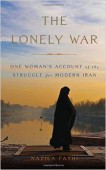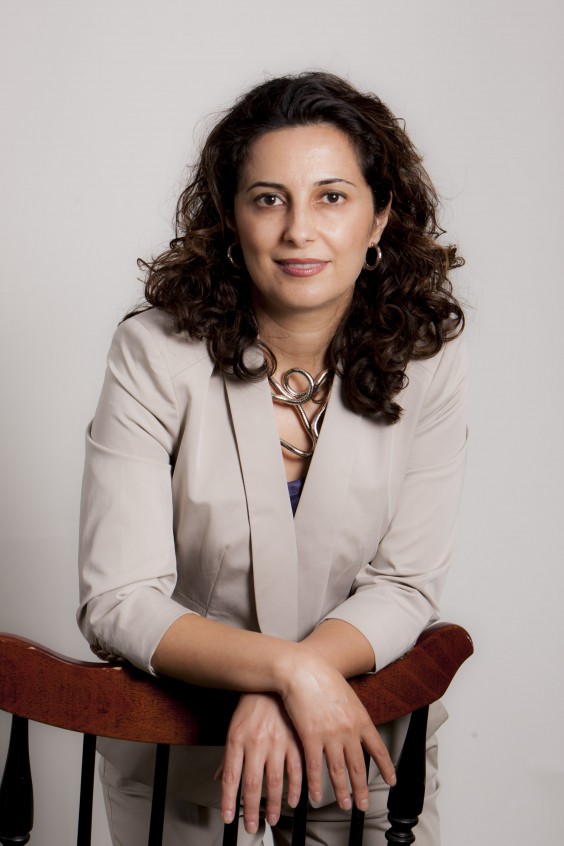The Lonely War: One Woman’s Struggle for Modern Iran
by Nazila Fathi / January 6, 2015 / No comments
In 2009, Iranian journalist Nazila Fathi she received a phone call from a source telling her that the government was coming after her. She was forced to flee, and has lived in exile ever since. The Lonely War intertwines memoir with two decades of reporting and interviews, examining the history of post-revolution Iran alongside Fathi’s personal history.
Born in Tehran, Nazila Fathi was nine years old when when the shah was replaced with the radical Islamic regime. For 15 years she reported on Iranian politics for the New York Times. Currently, she writes for NPR and Foreign Policy. Fathi has held multiple Harvard fellowships, as well as a fellowship at Lund University in Sweden. She is a frequent guest on BBC, CNN, and NPR.
_______
When I was ten years old and entering the third grade, my mother stopped my younger sister and me at the front door of our Tehran apartment on the first day of school. “If anyone ask you whether your parents support the revolution,” she told us, “you must say, ‘Yes, they do.”
I nodded solemnly. She didn’t have to explain; these were the rules of the new Iran, and although I was only a child, I understood them all too well.
Less than a year had passed since the 1979 revolution that replaced the Iranian monarch, Shah Mohammad Rezaa Pahlavi, with a conservative Islamic government, but we had already learned that if our parents were identified as anti-revolutionaries, they could face the firing squad. My friend’s father had been executed, my father’s friend was killed, and we knew many ordinary young people who had disappeared into the country’s prisons, all for the crime of opposing the new regime. The first lesson the revolution taught me, then, was to lie to protect my family and myself.

The Lonely War. Credit: Basic Books
The revolution took away Iranians’ personal liberties, but it also gave many people a taste of power and opportunity that had long been denied to them. Those who continued supporting the Islamic regime despite its repression came from impoverished and traditional families that had never embraced the former regime’s modernizing policies. Whereas the shah had robbed them of their religious identity by introducing secular schools and secular courts to Iran, the new regime’s leader, Ayatollah Ruhollah Khomeini, reorganized Iranian society in a way that prioritized religious values. The regime drove the old governing classes out of power and replaced them with its own supporters. It mustered all levels of conservative Iranian society, encouraging traditional women to take responsibility outside the house. After the regime enforced segregation, families that had balked at the prospect of coed public spaces finally felt comfortable sending their daughters to school, to university, and into the workforce. Far from chafing at the new regime’s restrictions, these women felt empowered.
The regime drew a huge number of Iranians from the margins of society into its center—and not just women. To satisfy its rural supporters, the government improved the quality of life in villages. It provided rural areas with electricity and clean water, and built roads that connected them to modern city life. The country’s new leaders offered rural Iranians upward mobility on a fast track, in the process providing the rural poor with a new identity: they became the enforcers of the new laws.
Over the years, a large section of this once-impoverished population became part of Iran’s middle class, in a socioeconomic revolution driven by major demographic changes. Two-thirds of the country’s population was born after the revolution; these young men and women studied, traveled abroad, and—from the early 1990s on—were exposed to new ideas and opinions through technologies such as satellite television and the Internet. Today, more than 70 percent of Iran’s population lives in cities, compared to less than 50 percent before the revolution. More than 60 percent of Iranian university student are women, and Iranians under the age of twenty-four have a literacy rate of over 99 percent. By 2009, 43 percent of the population was identified as middle-class—30 percent of which is rural—and another 40 percent as lower-middle-class, together more than two-thirds of Iran’s population.
This newly expanded middle class longs for a regime that can deal with critical matters of running the country rather than busying itself with what its citizens do in their private lives. Satellite television and the Internet have exposed the population to a global culture that defines the job of the government as providing comfort and opportunities for its citizens. As a result the desire for economic prosperity and political and social freedoms has spread among the majority of people.
Whereas technology has propelled positive change in Iran, the country’s vast material wealth has often impeded it. The revenue from the country’s thriving oil industry enabled the regimes both before and after the revolution to splurge on their political goals without needing a genuine base of support. Nationalized in 1952, the oil industry has been a source of inequality as well as progress. The Islamic regime relied on oil revenue to wage eight years of war with Iraq and to solidify its rule by rallying the Iranian people against an outside enemy. Yet the regime also rewarded its supporters with jobs in the civil sector, provided free public education from kindergarten to university to all Iranians, and thereby expanded the very middle class that would someday come to oppose many of its most hard-line policies.
Excerpted from The Lonely War: One Woman’s Account of the Struggle for Modern Iran by Nazila Fathi. Available from Basic Books, a member of The Perseus Books Group. Copyright © 2014.





